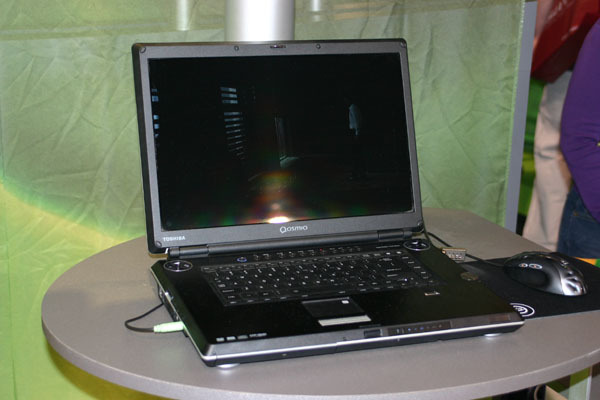CES 2006: Toshiba announces Qosmio notebook computer with HD DVD-ROM drive
While there are no commercial HD DVD titles out yet, several studios will be trickling out movies in the coming months. These movies will have up to 1920 X 1080 pixel resolution, which is far more than Qosmio currently supports. The existing model G25-AV513, with a 17" screen, goes as far as 1440 x 900 pixels. The HD DVD drive in this system, as with all HD DVD drives, is backwards compatible with current DVD content.
An official with NVIDIA, which produces the GeForce Go 7800 GPU for Toshiba's new Qosmio, told TG Daily that his company's card - and therefore the Qosmio - will support H.264, the encoding scheme of choice for MPEG-4. The compression scheme in H.264 allows higher quantities of video content to be streamed through lower bitrates. Last month's upgrade by rival ATI to its Catalyst drivers saw the addition of support for variable bitrate encoding, for its X1800 Crossfire series cards. Although NVIDIA has officially had H.264 support since the introduction of 7800 GTX in June, the fact that bitrates are variable could dramatically affect the quality of output to notebook computers.
As NVIDIA's product marketing manager for mobile products, Ravi Kaushik, told us today at CES, the GeForce Go 7800 card that powers the new Qosmio will be capable of decoding H.264 at a final output rate (not the streaming bitrate) of 15 - 20 Mbps. Lower-class GPUs in NVIDIA's product line, such as the 7400, will do about 10 - 11 Mbps, he said. (The output rate necessary for the average standard-resolution DVD, by comparison, is aboug 4 Mbps.) Figures we've seen regarding ATI X1800 output rates of as high as 40 Mbps, may lead us to wonder whether Qosmio's output capability is indeed as high as it can be. On the other side of the argument is the fact that H.264 reduces the bitrate necessary to decode video streams. And since Qosmio is a notebook computer, with total resolution a tad lower than 1080p, 40 Mbps might not even be necessary for such a display.
The other issue relating to multimedia quality is sound; and while we're arguing about whether a screen is capable of displaying high resolution, how will Qosmio's speakers handle the system's on-board Dolby sound system? Dolby's Surround Sound has been used for decades in movie theaters to reproduce multi-directional sound with high treble and low heart-thumping bass. Using Dolby's Virtual Speaker system, the Qosmio will mix audio waves to selectively cancel out sounds. Dubbed "Crosstalk Cancellation," this will trick your ears so that you think no sound is coming from the left or right speaker at certain times.
The Qosmio will run Windows Media Center, and have an integrated analog TV tuner. Like other notebooks in the Qosmio line, it will automatically play CDs and DVDs with the Windows Operating System booted. While not announcing pricing, Toshiba says the new Qosmios should be available in March.
Get Tom's Hardware's best news and in-depth reviews, straight to your inbox.

